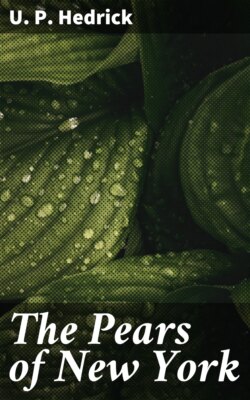Читать книгу The Pears of New York - U. P. Hedrick - Страница 26
На сайте Литреса книга снята с продажи.
PEAR STATISTICS FOR THE UNITED STATES AND NEW YORK
ОглавлениеTable of Contents
Six states produced over 65 per cent of the pears grown in the United States in 1919. The census of 1920 shows that in the preceding year the total crop of the country was 14,211,346 bushels, of which California produced 3,952,923 bushels; New York, 1,830,237 bushels; Washington, 1,728,759 bushels; Oregon, 761,063 bushels; Texas, 637,400 bushels; and Missouri, 430,828 bushels. Trees in all other states yielded 4,870,136 bushels. There were according to this census 14,646,995 bearing trees and 6,051,845 not of bearing age. The yield of fruit was 60 per cent greater than in 1909; the number of bearing trees 3 per cent less; and the number of non-bearing trees 28 per cent less. Compared with other tree-fruits, according to this census, the pear occupies fourth place in value of product, the apple, peach (including the nectarine), and plum (including the prune), in order named, outranking the pear. Probably the orange, grape, and strawberry yield greater value to the country than the pear, although the acreage of each of these three fruits is smaller. Commercial production cannot be segregated from the total, but without question the increase in plantings is due to commercial activities; for the development of the canning industry, refrigerator service, and better transportation have greatly stimulated trade in this fruit.
In the states in which pear-growing is a commercial industry, commercial orchards are confined to localities in which climate, soil, and transportation combine to favor the pear. In New York, for example, pears are grown for market on a large scale in only ten of the sixty-one counties. These, with the number of trees in each, according to the last census are as follows: Niagara, 620,743; Monroe, 384,374; Orleans, 377,371; Columbia, 308,298; Wayne, 305,239; Ulster, 304,158; Greene, 208,885; Oswego, 154,576; Ontario, 121,934; Orange, 96,456.
Over 77 per cent of all the pear-trees in the State are in these counties, and 79 per cent of the pears grown in the State are produced in these ten counties. The production of pears in New York for the eleven-year period from 1909 to 1919, inclusive, show the increase and fluctuation in the production of pears in the State for this period. The figures for 1909 and 1919 are from the thirteenth and fourteenth census reports, while those of the intervening years are estimates from the Bureau of Crop Estimates of the United States Department of Agriculture. The yields run in bushels for the eleven years as follows: 1,343,000, 1,530,000, 1,886,000, 1,128,000, 2,016,000, 1,298,000, 1,375,000, 1,675,000, 1,708,000, 1,352,000, and 1,830,237.
Bartlett and Kieffer are conspicuous leaders among varieties in number of trees and in production for the whole country. In the great commercial pear-growing regions of New York and California, Bartlett is the favorite variety, but Kieffer is grown largely also, especially for canners. In the South and in the Mississippi Valley, Kieffer is the leading variety because it is relatively resistant to blight and withstands extremes in climate better than other varieties. For many years after its introduction about 1870, Kieffer was over-praised by both fruit-growers and nurserymen. Fruit-growers liked it because of its resistance to blight and great productiveness, and nurserymen preferred it to other sorts because it is the easiest of all varieties to grow in the nursery. It is, however, so universally condemned for its tasteless fruits that it is losing its popularity, and is not now as largely planted in competition with Bartlett as it once was. Seckel, Clapp Favorite, Winter Nelis, Beurré d’Anjou, Beurré Bosc, Howell, Sheldon, Beurré Clairgeau, and Garber for the South, are the standard varieties following Bartlett and Kieffer in popularity.
Bartlett is far in the lead of commercial varieties in New York. At present, Kieffer probably holds second place in this State, but its popularity is fast waning and Seckel is nearly as commonly planted, if, indeed, it does not now surpass Kieffer in number of trees. Clapp Favorite, Beurré d’ Anjou, Beurré Bosc, Beurré Clairgeau, Duchesse d’Angoulême, Howell, Lawrence, Sheldon, Vermont Beauty, and Winter Nelis are all planted more or less in commercial orchards, and are the favorites for home use. All of these varieties are susceptible to blight, are a little too tender to cold, and have other faults of tree and fruit, so that pear-growers in New York anxiously look forward to better varieties. It is hardly too much to say that pear-growing can never become a great industry in New York until better varieties take the place of the unreliable sorts that must be planted now.
To some extent, man-governed agencies determine where pears may be grown profitably if the planter is growing for the markets. Pears do not keep long and are easily bruised, and transportation must not take too great toll; therefore, handling facilities must be suitable, markets must not be distant, and transportation must be cheap and efficient. But in the culture of this fruit, natural agencies outrank those depending on man, two of which determine very largely where pears are to be grown commercially in both the country and the state. These two, climate and soil, have been mentioned before, but must now be discussed somewhat in detail.
